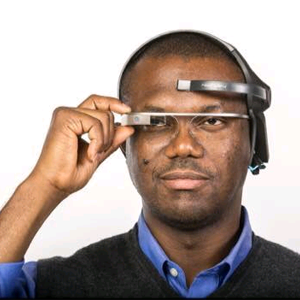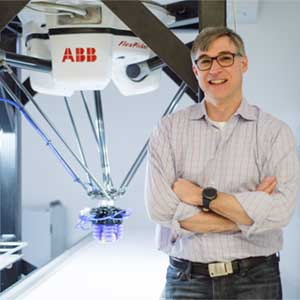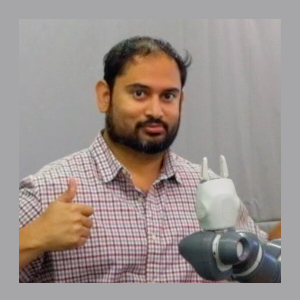- CVP-Advanced
 |
Vision Product Manager, Omron Microscan CVP-Advanced Certification - Advanced Vision Lighting Designed for the engineering professional, this course concentrates on real world techniques for successful illumination. You'll learn how to select proper illumination wavelengths and how to deal with complex part surface geometries. Other topics include illumination integration, and controlling back reflections. Prior attendance at a Basic Lighting course is encouraged, but not required. |
- CVP-Basic
 |
Staff Engineer, Intelligent Robotics/Machine Vision, FANUC America Corporation CVP-Basic Certification - The Fundamentals of Machine Vision You'll learn all the basics, including how images are captured and transferred to the computer, the principles of lighting, and the common processing algorithms used by machine vision systems. Discover how to successfully implement machine vision and how to avoid common pitfalls during the implementation, launch and production phases. This is an ideal training course for people new to machine vision as well as a great refresher course for anyone with machine vision responsibilities. |
CVP-Advanced Certification Course
Reliable Vision Application Development- CVP-Advanced
 |
Robert W. Tait GE Global Research, US CVP-Advanced Certification - Reliable Vision Application Development Producing a reliable vision system is no accident. It begins with creating a strong specification that carries through to component selection to system development and finally deployment. This course will help the end user and the integrator walk through the steps needed to enhance their projects success. Individuals of all experience levels will benefit from the techniques that will be conveyed during this course. |
- CVP-Advanced
 |
Expert - 3D Vision Core Design, SICK IVP AB CVP-Advanced Certification - 3D Vision System Development Learn how advancements in 3-D camera technology are enabling new solutions for more applications than ever before. Review the many vision-based 3-D measurement techniques and which achieve the best results. This session will provide real application techniques you can use in electronics, pharmaceutical, food & beverage, aerospace, automotive and many other industries. |
- CVP-Basic
 |
Technical Sales & Product Specialist, Advanced Illumination CVP-Basic Certification - Beginning Lighting for Machine Vision This course focuses on basic lighting geometry. Learn how and where light fits into the energy spectrum, review components of the machine vision front end to understand how they impact the images acquired by the system. |
- CVP-Basic
 |
Vice President, Imaging Business Unit, Edmund Optics CVP-Basic Certification - Beginning Optics for Machine Vision This course focuses on the basics of illumination optics. Learn how to define the fundamental parameters of optical layout. Get a real world understanding of how to balance your system's field of view, resolution working distance, and depth of field. |
- CVP-Advanced
 |
Staff Engineer – Intelligent Robotics/Machine Vision, FANUC America Corporation CVP-Advanced Certification - Advanced Vision System Integration This course will detail proper techniques for implementing a vision system including application analysis, project specification and implementation of components. It will also address integration of a machine vision system into a full automation system including network communications. Attendees should possess a basic understanding of machine vision, optics and lighting. |
- IIOT
 |
Product Marketing Manager, Industrial Solutions Division, Image Sensor Group, ON Semiconductor Advances In Image Sensor Technology - One Size Doesn't Fit All |
- Vision Integration
 |
CEO, Pyramid Imaging Guidelines For Successful Machine Vision Integration |
- Life Sciences
 |
TBD Sensor to Image Life Sciences Course 1 |
Helen Greiner, Robot Visionary
(free to all attendees)
- Keynote
 |
Robot Visionary Presentation title and description coming soon. |
- IIOT
 |
CEO, Photoneo Revolutionary 3D Camera Technology |
- Vision Integration
 |
CEO, Cyth Systems Neural Vision - Machine Vision's Move To Artificial Intelligence |
- CVP-Advanced
 |
Sr. Technical Director, Ruda Cardinal, Inc. CVP-Advanced Certification - Advanced Optics for Vision Designed for the engineering professional, this course concentrates on real world techniques for putting together optic systems that work. You'll learn how to select proper lens components, optomechanical layout, including system bends, and mounting techniques. Prior attendance at a Basic Optics course is encouraged, but not required. |
CVP-Basic Certification Course
The Fundamentals of Camera and Image Sensor Technology- CVP-Basic
 |
1st Vision CVP-Basic Certification - The Fundamentals of Camera and Image Sensor Technology Gain a basic understanding of camera design, from analog to digital cameras. Find out about different camera types and their capabilities. Learn about capabilities of different camera outputs from analog to USB to Camera Link. Other topics include CCD and CMOS sensors, the capabilities of monochrome versus color sensors, area scan and line scan arrays, and which cameras are best suited for specific vision applications. |
- Life Sciences
 |
TBD Sensor to Image Life Sciences Course 2 |
- IIOT
 |
Product Marketing Manager, FLIR Systems Transitioning From GigE to 10 GigE 10 Gigabit Ethernet (10GigE) combines high bandwidth with ease of use, low latency, and long cable length. This makes it the ideal interface for the next generation of machine vision systems. The 10GBASE-T implementation of 10Gigabit Ethernet builds on the strengths that have propelled Gigabit Ethernet to its position as the dominant machine vision interface. The Oryx 10 GigE camera will be introduced. |
- Vision Integration
 |
Director, Imaging, ATS Automation A Process For Transforming Fully Manual Inspection To Fully Automated Inspection |
- Life Sciences
 |
TBD Sensor to Image Life Sciences Course 3 |
- Vision Integration
 |
Application Engineer Leader & Product Specialist, Datalogic Better Identification Equals Better Reliability And Tracking Of Goods |
- IIOT
 |
Derek Kuhn Sciemetric Giving Machine Vision Data Its Due As Part Of A Manufacturing 4.0 Strategy |
CVP-Advanced Certification Course
Advanced Camera and Image Sensor Technology- CVP-Advanced
 |
GM - Business Development, CCS America CVP-Advanced Certification - Advanced Camera and Image Sensor Technology Explore the different levels of image quality at the sensor level. Details relating to quantum efficiency, dark noise, signal to noise ratio will be discussed in detail. In addition to topics related to area scan cameras, the proper usage of line scan and TDI cameras will be reviewed. Sensor size Courseification and new camera mounting standardization will be covered. |
- CVP-Basic
 |
Principal Software Engineer, National Instruments CVP-Basic Certification - Image Processing Fundamentals In this Course you'll gain an understanding of how machine vision and imaging algorithms work. These fundamentals will be used to show a variety of ways to solve real world industry application challenges. Attendees will be exposed to the strength and capabilities that software can provide while gaining an understanding of complete imaging system requirements needed to optimize their application needs. |
- IIOT
 |
Festo Didactic Grooming The Next Generation Automation Capable Workforce For Industry 4.0 |
- Vision Integration
 |
Vice President, CCS America Inc. Getting The Image You Need With Computational Imaging |
- Vision Integration
 |
Founder and CEO, Think and Zoom Using EEG And Computer Vision To Augment Poor Eyesight |
- Networking Party
 |
Jillian's Lucky Strike - Additional $35 fee Join 500 exhibitors, attendees, and industry leaders at The Vision Show networking party. Enjoy food, drinks, bowling, pool, and foosball while strengthening current connections and making new ones. |
- IIOT
 |
Account Manager, McNaughton-McKay Electric Company What Is 'Video Vision'? |
- Vision Integration
 |
Project Manager, Sill Optics Telecentric Lenses With Tunable Working Distance - Benefits For Automated Inspection |
- Life Sciences
 |
Andrew Winig Elevator Pitch Coach, ImprovAndy AIA Core Business Essentials: Starting Conversations at Conferences |
Diego Prilusky - General Manager, Intel Studios
(free to all attendees)
- Keynote
 |
General Manager, Intel Studios Presentation title and description coming soon. |
- IIOT
 |
Staff Engineer, Fanuc America Corporation Vision Guided Robotics - The Future Of Flexible Automation |
- Vision Integration
 |
Product Manager, Vision, National Instruments Necessary Software Tools For Vision In Robotics |
CVP-Advanced Certification Course
Advanced Color Machine Vision and Applications- CVP-Advanced
 |
Vice President Business Development, Graftek Imaging, Inc. CVP-Advanced Certification - Advanced Color Machine Vision and Applications Color is important for a growing number of machine vision applications in food, pharmaceutical, automotive and many other markets. This course will start with how color images are formed and then review aspects of human color vision that are important in designing a color machine vision system. Then we concentrate on how to build and apply color machine vision systems to tasks such as automated inspection, tracking, identification and color matching. |
- IIOT
 |
Sr. Embedded Developer, Prolucid Technologies Machine Learning For Vision Based Inspection And Verification |
- Vision Integration
 |
Vision Product Manager, Omron Microscan Ensuring 100% Traceability And Quality Of Your Products Using Machine Vision Code Reading |
 |
Editor in Chief, Vision Systems Design |
 |
Group Publisher, PennWell This session is powered by AIA's Core Business Essentials program which provides in depth coaching from experienced industry veterans with decades of combined success in the vision and imaging field.
Key take-a-ways include:
|
Certified Vision Professional – Basic Level EXAM
- Vision Integration
 |
President, WAY-2C Selecting The Most Relevant Identification Information In Spectral Images |
- IIOT
 |
President, MVTec Deep Learning, Classification And Their Applications In Machine Vision |
- Vision Integration
 |
Manager - Technical Services, FRAMOS Technologies The Depths Of 3D: The Many Technologies Of Depth Data Generation |
- IIOT
 |
President, Moritex North America 3D imaging and measurement solutions have finally become feasible for implementation in machine vision. For non-contact 3D measurement, the most common methods include : (1) "Light (Laser) profiling method", (2) "Stereo camera method" and (3) "Active pattern projection method". |
- CVP-Advanced
 |
Staff Engineer, Intelligent Robotics/Machine Vision, FANUC America Corporation CVP-Advanced Certification - Advanced Vision Guided Robotics Vision guidance is common in robot applications. This course will detail proper techniques for implementing a vision guidance system and will include the latest technology advances. Attendees should possess basic robotic and system integration knowledge. |
CVP-Advanced Certification Course
Designing High-Speed and Linescan Vision Systems- CVP-Advanced
 |
President, Automated Vision Systems, Inc. CVP-Advanced Certification - Designing High-Speed and Linescan Vision Systems In this course you learn how latency and determinism relates to high-speed and to real-time performance and how the different types of vision system components affect the latency of the vision system. Topics cover components for image acquisition as well as different approaches to image processing, including processing architecture/hardware, operating system, application software, and resynchronization. You’ll learn about the performance parameters you must know to quantify speed and real-time performance and a methodology for guiding the design of a vision system. Example designs illustrate how you use these parameters and techniques to achieve design performance goals. |
- IIOT
 |
Sales Manager 3D Sensors, AT - Automation Technology Optimized Design Of 3D Laser Triangulation Systems |
- Vision Integration
 |
Vice President, Gardasoft LLC When, Where, And How To Use An LED Lighting Controller |
- Vision Integration
 |
Systems & Solutions Engineer, Midwest Optical Systems Choosing The Best Optical Filter For Your Application |
- IIOT
 |
Partner, Optical Metrology Solutions 3D Optical Metrology: New Capabilities for a New Era |
- IIOT
 |
CEO, Ximea Corp. PCI-e: A New Paradigm For Imaging? |
- Vision Integration
 |
General Manager, EMEA, Lucid Vision Labs GmbH Inspection with Polarization Sensor - Imaging the Unseen Material shape, reflectivity and surface roughness are important properties for material inspection and classification. Light's polarization is often overlooked when considered among other inspection and classification methods. Many vision systems face challenges in identifying key features under low contrast or highly reflective imaging conditions. With the help of polarization cameras, many material properties that were impossible to identify with regular RGB sensors can be easily acquired now. In this presentation, Lucid Vision Labs will discuss the polarization imaging technology and its applications. Polarization imaging can be a cost-effective way to solve these imaging challenges and uncover hidden material properties to better perform inspection and classification in modern-day quality assurance processes. |
- Vision Integration
 |
Senior Software Engineer, National Instruments Building Deterministic, Low-Latency, & High-Throughput Vision Systems |
CVP-Advanced Certification Course
Non-Visible Imaging Theory and Techniques- CVP-Advanced
 |
President, Princeton Infrared Technologies, Inc. CVP-Advanced Certification - Non-Visible Imaging Theory and Techniques Non-visible imaging methods offer unique benefits for a variety of vision tasks. In this session, you'll learn more about infrared and thermal techniques and better understand if non-visible imaging solutions are right for your specific needs. |
- Vision Integration
 |
Vision and Automation Sales Manager, Radix Inc. The Ability to Digitize Manual Processes for Data Input and Error Proofing |
CVP-Advanced Certification Course
Particle Analysis and Classification Techniques- CVP-Advanced
 |
President, Automated Vision Systems, Inc. CVP-Advanced Certification - Particle Analysis and Classification Techniques The ability to correctly analyze and classify details and particles in an image can be critical to the success of an imaging application. Strategies around thresholding, advanced morphology and the correct usage of particle filters will be covered. Additional topics include training strategies, images transforms, and image filtering. |
CVP-Advanced Certification Course
Metrology and 2D Calibration Techniques- CVP-Advanced
 |
Director of Core Vision Tool Development, Cognex Corporation CVP-Advanced Certification - Metrology and 2D Calibration Techniques Participants will gain an understanding of techniques for creating systems that yield reliable and repeatable measurement results. Practices for proper calibration of imaging systems ranging from appropriate usage of targets to accurate algorithm deployment will be discussed. How to manage images correctly to create repeatable results will be reviewed. Anyone who is developing metrology systems or having and need for accurate measurements will benefit from this curriculum. |
CVP-Advanced Certification Exam

Collaborative Track: $795
VIP All Access Pass (includes access to The Vision Conference): $1,850
- Collaborative Robots
 |
Sales Engineer, ARC Specialties Inc. Traditional vs. Collaborative Robots Traditional Robots have been around since the late sixties and early seventies as hydraulic actuated arms with early versions of computerized numerical control controllers and to today's high accuracy servo arms with digital high speed PC/motion control and with the latest interface for communications. Collaborative Robots are somewhat new to the manufacturing environment with the ability to work within close proximity to human workers without the fear of harming them. Collaborative robots are flexible with high speed processors that are easy to set-up and program. Collaborative robots are ideally suited for assembly production lines with close human interaction. |
Innovative Advances that Ease Adoption of Robot Automation Technologies
- Collaborative Robots
 |
READY Robotics Corporatin Breaking Barriers to Automation - Innovative Advances that Ease Adoption of Robot Automation Technologies Traditionally, robot automation has been difficult for a large number of manufacturers to access due to a variety of factors including cost, integration effort, and poor application fit. Recent technological advances have made it possible for many of these users to leverage robotic automation in ways impossible in years past. In this talk we will discuss how innovative technologies are breaking these traditional barriers by reducing the learning curve for programming, integrating, deploying and redeploying these systems in a variety of new applications, and how innovative business models are making it easier than ever for end users to place a robot in their factory. |
- Collaborative Robots
 |
Safety Champion, Balluff Collaborative Robot Applications, Sensor Networks and IIoT/Industry 4.0 Recent developments in sensor level networks offer robot OEM and user benefits including faster & cheaper integration/startup through reduction in cabling, standardized connectors/cables/sensors and device parameterization. Better connection between sensors and controller supports robot supplier implementation of Industry 4.0/IIoT by making it easier to gather process, device and event data - this allows improved productivity/uptime, better troubleshooting, safer machines, preventative maintenance, etc. Sensor level networks enable closer human-robot collaboration by making it easier to align the robot's restricted and safeguarded spaces, simplifying creation of more dynamic safety zones and allowing creation of "layers" of sensors around a robot work area. |
- Collaborative Robots
 |
CTO, Advanced Robotics for Manufacturing (ARM) From Biologically Inspired Robots to Collaborative Manufacturing Systems The robotics field is experiencing a renaissance in the use and implementation of biologically-inspired approaches, most commonly seen in today’s transition from wheels and tracks to animal-inspired movements. With this transition, robots have become more collaborative in nature and better able to navigate their surroundings, allowing them to work more seamlessly and safely alongside human workers. An iconic example of a biologically influenced robot comes from Dr. Choset and his research group’s development of snake robots. These snake robots are highly articulated robots that use many joints to thread through tightly packed volumes to access hard-to-reach locations through snake-inspired movements. In more traditional environments, the operators direct the joints, internal degrees of freedom, etc. to move to a position at a designated speed. In less predictable settings, like nuclear facility repair, the robots are controlled using compliance and force feedback information throughout the mechanism. While these snake robots have been deployed in diverse situations, including search and rescue efforts, the innovations from the development have also been successfully implemented in manufacturing environments, where precise models of the environment are more readily available. The innovations in utilizing compliance and force feedback for movement in unstable environments make the robots safer to work with and around humans in traditional settings. In his presentation, Dr. Choset will share ways that modular robots – inspired by nature - can speed industrial automation, make collaborative robots safer, and how ARM is advancing the use of industrial robots through technology development and education. |
- Collaborative Robots
 |
Group Manager Automation, SCHUNK Grippers in Human-Robot-Collaboration How is the development of Human-Robot-Collaboration affecting requirements for end-of-arm-tools like grippers: Learn how grippers are following the development from completely automated robot cells to human-robot-collaboration. Understand how the requirements for end-of-arm-tools are changing in collaborative applications and how these requirements will define a new segment of grippers. Types of Human-Robot-Collaboration defined in the standards: Depending on the application environment and requirements for throughput, flexibility or space constraints, different levels of human-robot-collaboration can be used. Learn what types of human-robot-collaboration are defined in the standards and what advantages and limitations come with each one. Motivation for human robot collaboration and areas where it is used: Understand what the terms Coexistence, Synchronized, Cooperation, Collaboration mean and how they affect the performance of an application. Learn how to select a gripper and which factors are most important in finding the right gripper for your application. |
- Collaborative Robots
 |
Director of Standards Development, Robotic Industries Association (RIA) Safety in Collaborative Robotics What is a collaborative robot? Are collaborative robots "safe right out of the box"? How can you be confident that your new collaborative robot system is actually safe to operate in close proximity to your personnel? This talk will cover some common myths and misconceptions about collaborative robotics; introduce you to the relevant safety standards for collaborative robot systems; and provide practical ideas to help you ensure the safety of your collaborative robot system. |
- Collaborative Robots
 |
Manager of Medical Robotics, KUKA Robotics Robotics in healthcare is a true example of collaboration. In this presentation, Corey Ryan from KUKA Robotics will address the medical market for robotics in healthcare, the types of robots that are deployed in hospitals today from surgery to rehab, and what we may look forward to in the future. |
- Collaborative Robots
 |
Dwight Morgan ABB Collaborative Technologies Expands Roll of Robotic Automation into Low Volume/ Hi-Mix Manufacturing and Intralogistics For the first time in the history of robotics, there are both large enterprise players and innovative startup companies focusing on extending the role of robotics beyond manufacturing and into new collaborative applications such as logistics, small batch assembly, and other non-traditional automation application. This session will explore how emerging technologies in safety sensors and machine vision are enabling, for the first time ever, the collaboration of human workers working alongside robots in new applications both within and outside of the conventional factory environment. |
- Adaptability and Agility in Collaborative Robotics
 |
CEO, Soft Robotics Collaborative - Adaptability and Agility in Collaborative Robotics One of the benefits of collaborative robots is the reduced required infrastructure investment like safety fencing and other fixed installations. A result of this has been the re-tasking of the robot with product and production line changeover, and event semi-fixed cells that are physically moved around a manufacturing facility. A requirement of this flexibility is an agile and adaptive cell design. This has impacts on how the cell is designed, the material flow, and supporting technology like vision systems and end effectors. This talk will present a high level overview of these applications and what users should consider when evaluating this type of deployment. |
- Collaborative Robots
 |
Tony Melanson Aethon Connecting Islands of Automation with Mobile Robotics Autonomous Mobile Robots are becoming widely accepted in manufacturing and being deployed in a broad range of environments and applications. Production processes have been long automated, but the movement of material continues to be a manual process. This session provides an overview of the opportunities to automate material movement and the capabilities that are important when considering autonomous mobile robot delivery solutions. |
- Collaborative Robots
 |
FANUC Robotics Collaborative Robot Technologies & Customer Applications |
- Collaborative Robots
 |
Senior Director, Hardware, VEO Robotics The Future of Collaborative Robotics Collaborative robots have been transforming industrial automation, enabling use of robots in many applications where it wasn't practical to use them before. However, the current generation of collaborative robots sacrifice performance to achieve safety. Speed and separation monitoring can be used to achieve safe collaboration for robots of any size, speed, and strength. But understanding a scene well enough to enforce these constraints requires powerful sensing capabilities. Perception-based human/robot collaboration places a number of challenging requirements on sensor technology. Sensors must have wide field-of view and long range. Since handling of occlusions in 3D space is critical, multiple sensors must operate without interference. Because high performance robots move very quickly, sensors must have low latency and high frame rate. And sensors must meet functional safety requirements for reliability as laid out in the ISO standards. Using perception and intelligence, we no longer have to limit collaboration to smaller, weaker robots. We can allow even the largest and most powerful robots to work closely with people. This will allow manufacturers to combine the creativity, dexterity, and judgement of people with the strength, speed, and precision of robotics. We believe this will increase both productivity and agility, and enable manufacturers to meet the ever growing demands of the modern economy. |
- Collaborative Robots
 |
President, Productive Robotics Moving from Easy to Simple "Easy" programming languages are only easy for programmers. For most people, programming is not easy, regardless of the language. To make robots really accessible and drive growth, robot programming must be improved. One approach to that will be presented. |
- Collaborative Robots
 |
Director, GMNA Vehicle Systems, General Motors Collaborative Robots: The General Motors Experience |
- Collaborative Robots
 |
Zach Tomkinson Sales Development Manager, Universal Robots Application-Specific, No-Compromise Vision System Design for Collaborative Implementations The challenges in integrating collaborative robots and vision systems is directly related to the advantages of the cobots themselves. One approach is to incorporate a camera into the robot itself, which relieves users of the complexity of choosing and integrating separate components. The second approach is to custom-design a vision system and integrate it with the robot for the exact requirements of each application. A third approach melds these options to provide the basis for no-compromise, application-specific systems. The concept relies on an ecosystem of vision components and software that have been tested and pre-certified to work with the collaborative robots. Together with built-in communication protocols in the robot, this approach allows companies to define exactly the right integrated system for each application and ROI requirement, and still maintain the ease of setup and programming and fast ROI that they expect of collaborative robots. |
- Collaborative Robots
 |
Founder, Southie Autonomy Works Rahul Chipalkatty is the founder of Southie Autonomy Works, a pre-seed-stage startup changing the way people interact with collaborative robots. In this presentation, Rahul will examine the collaboration gap between humans and collaborative robots. He’ll show how his research is working to fill this gap using AR/VR/MR, voice and gestures. This will help connect the workforce and in turn lower the barrier to robotics. |








